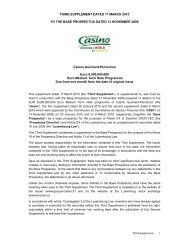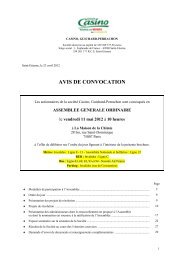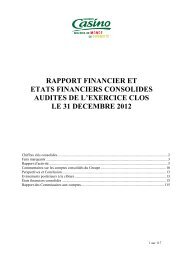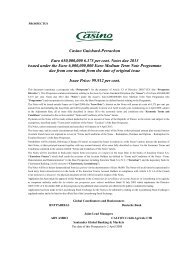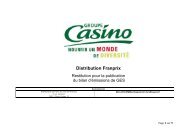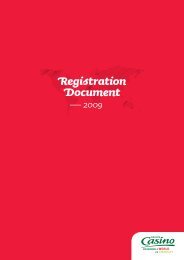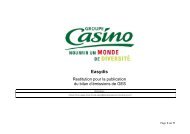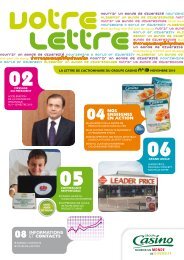2010 REGISTRATION DOCUMENT (3.4 Mo) - Groupe Casino
2010 REGISTRATION DOCUMENT (3.4 Mo) - Groupe Casino
2010 REGISTRATION DOCUMENT (3.4 Mo) - Groupe Casino
Create successful ePaper yourself
Turn your PDF publications into a flip-book with our unique Google optimized e-Paper software.
3CONSOLIDATED FINANCIAL STATEMENTSNotes to the consolidated fi nancial statementsNote 1.5.1<strong>3.4</strong>. Financial assets at fair valuethrough profi t or lossFinancial assets at fair value through profit or loss are financial assetsclassified as held for trading, i.e. assets that are acquired principallyfor the purpose of selling them in the near term. They are measuredat fair value and gains and losses arising from remeasurement at fairvalue are recognised in the income statement. Some assets maybe designated at inception as financial assets at fair value throughprofit or loss.These financial instruments mainly comprise units in eligible mutualfunds classified as current assets under cash equivalents.Note 1.5.13.5. Loans and receivablesLoans and receivables are financial assets issued or acquired by theGroup in exchange for cash, goods or services that are paid, deliveredor rendered to a debtor. They are measured at amortised cost usingthe effective interest method. Long-term loans and receivables thatare not interest-bearing or that bear interest at a below-market rate arediscounted when the amounts involved are material. Any impairmentlosses are recognised in the income statement.Trade receivables are recognised and measured at the originalinvoice amount net of any accumulated impairment losses. They arederecognised when all the related risks and rewards are transferredto a third party.Note 1.5.13.6. Available-for-sale fi nancial assetsAvailable-for-sale financial assets correspond to financial assetsnot meeting the criteria for classification in any of the other threecategories. They are measured at fair value. Gains and losses arisingfrom remeasurement at fair value are accumulated in equity untilthe asset is derecognised. When they are derecognised or when adecline in the fair value of an available-for-sale financial asset hasbeen recognised directly in equity and there is objective evidencethat the impairment is other than temporary, the cumulative loss thathad been recognised directly in equity is removed from equity andrecognised in the income statement.Impairment losses on equity instruments are irreversible and anysubsequent increases in fair value are recognised directly in equity.Impairment losses on debt instruments are reversed through theincome statement in the event of a subsequent increase in fair value,provided that the amount reversed does not exceed the impairmentlosses previously recognised in the income statement.This category mainly comprises investments in non-consolidatedcompanies. Available-for-sale financial assets are classified undernon-current financial assets.Note 1.5.13.7. Cash and cash equivalentsIn accordance with IAS 7, cash and cash equivalents consist of cashand investments that are short-term, highly liquid, readily convertibleto known amounts of cash and are subject to an insignificant risk ofchanges in value.Note 1.5.13.8. DerecognitionFinancial assets are derecognised in the following two cases:■■the contractual rights to the cash flows from the financial assetexpire; or,the contractual rights are transferred and the transfer qualifies forderecognition,- when substantially all the risks and rewards of ownership of thefinancial asset are transferred, the asset is derecognised in full,- when substantially all the risks and rewards of ownership areretained by the Group, the financial asset continues to berecognised in the balance sheet for its total amount.The Group has set up receivables discounting programmes withits banks. The Group considers that there is no risk of discountedreceivables being cancelled by credit notes or being set off againstliabilities. The receivables discounted under the programmes mainlyconcern services invoiced by the Group under contracts with suppliersthat reflect the volume of business made with the suppliers concerned.The other risks and rewards associated with the receivables havebeen transferred to the banks. Consequently, as substantially all therisks and rewards have been transferred at the balance sheet date,the receivables are derecognised.Note 1.5.14. Financial liabilitiesNote 1.5.14.1. Defi nitionsFinancial liabilities are classified into two categories as follows:■■borrowings recognised at amortised cost;financial liabilities at fair value through profit or loss.Financial liabilities are classified as current if they are due in less thanone year and non-current if they are due in more than one year.Note 1.5.14.2. Recognition and measurementof fi nancial liabilitiesFinancial liabilities are measured according to their category underIAS 39.Note 1.5.14.2.1. Financial liabilities recognisedat amortised costBorrowings and other financial liabilities are usually recognised atamortised cost using the effective interest rate method, except forinstruments qualifying for hedge accounting.Debt issue costs and issue and redemption premiums are included inthe cost of borrowings and financial debt. They are added or deductedfrom borrowings, and are amortised using an actuarial method.Note 1.5.14.2.2. Financial liabilities at fair valuethrough profit or lossThese are financial liabilities intended to be held on a short-term basisfor trading purposes. They are measured at fair value and gains andlosses arising from remeasurement at fair value are recognised in theincome statement.Note 1.5.14.3. Recognition and measurement ofderivative instrumentsNote 1.5.14.3.1. Derivative financial instruments thatqualify for hedge accounting:recognition and presentationAll derivative instruments (swaps, collars, floors and options) arerecognised in the balance sheet and measured at fair value.In accordance with IAS 39, hedge accounting is applied to:■fair value hedges (for example, swaps to convert fixed rate debtto floating rate). In this case, the debt is measured at fair value,with gains and losses arising from remeasurement at fair valuerecognised in the income statement on a symmetrical basis withthe gain or loss on the derivative. If the hedge is entirely effective,the loss or gain on the hedged debt is offset by the gain or losson the derivative;68 <strong>Casino</strong> Group | Registration Document <strong>2010</strong>



